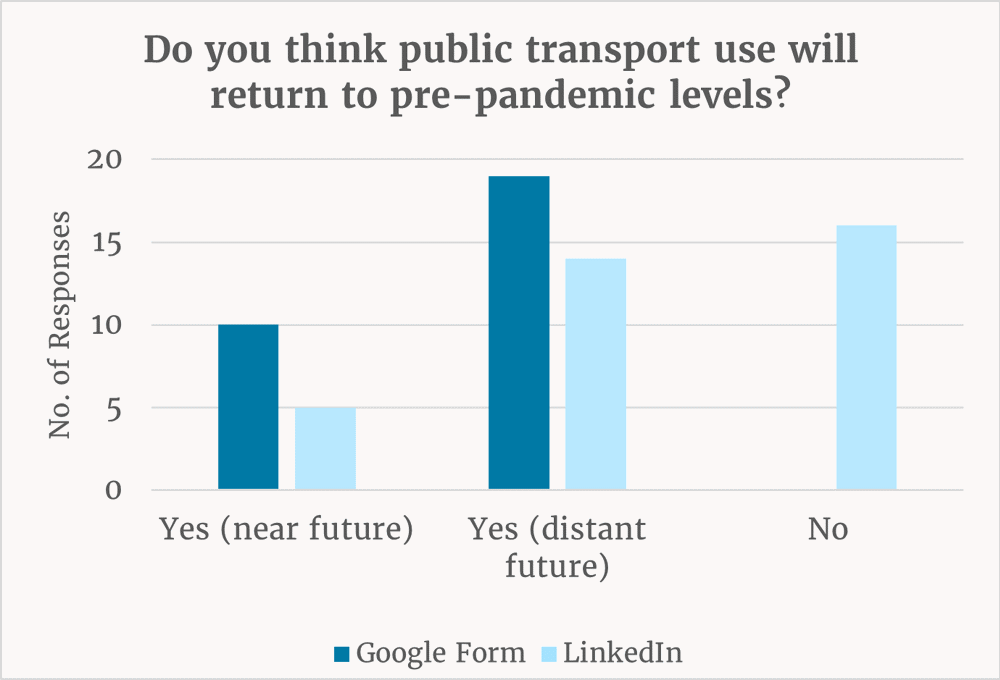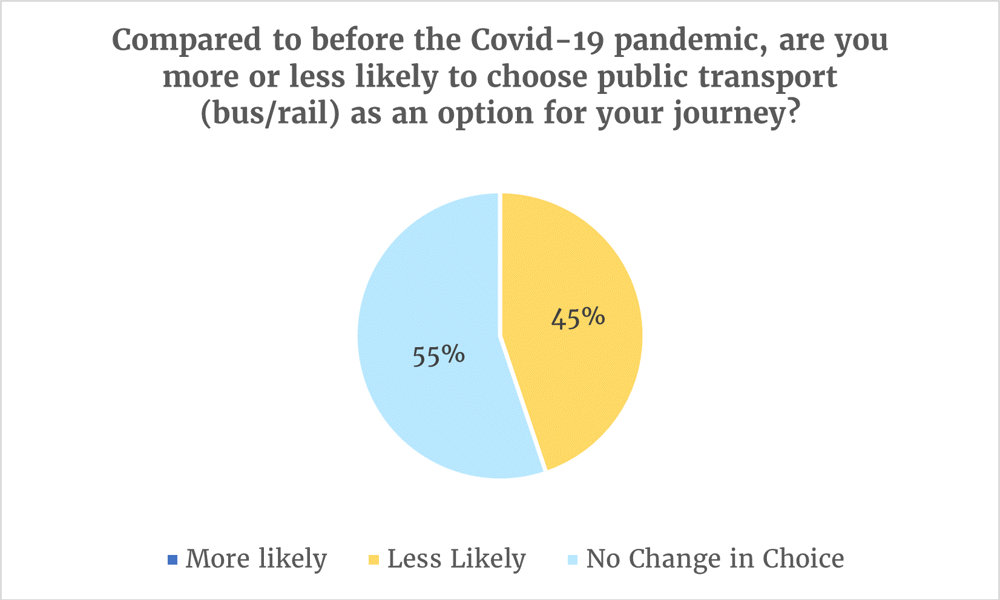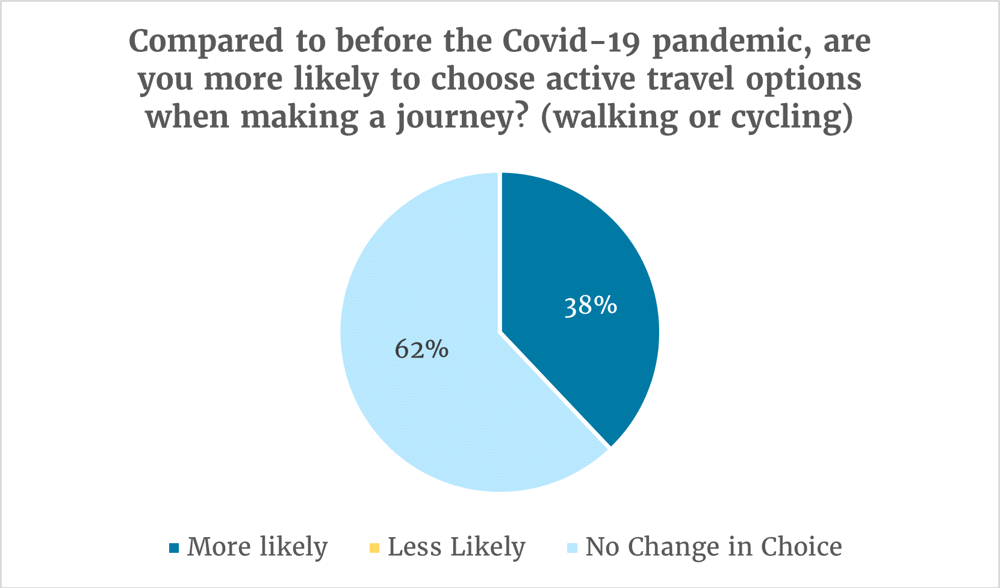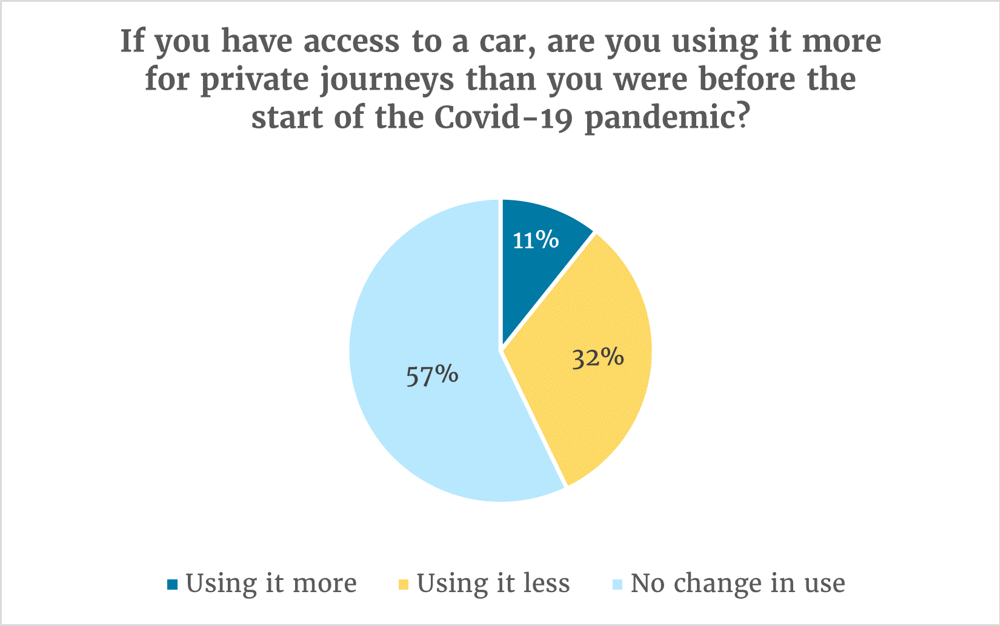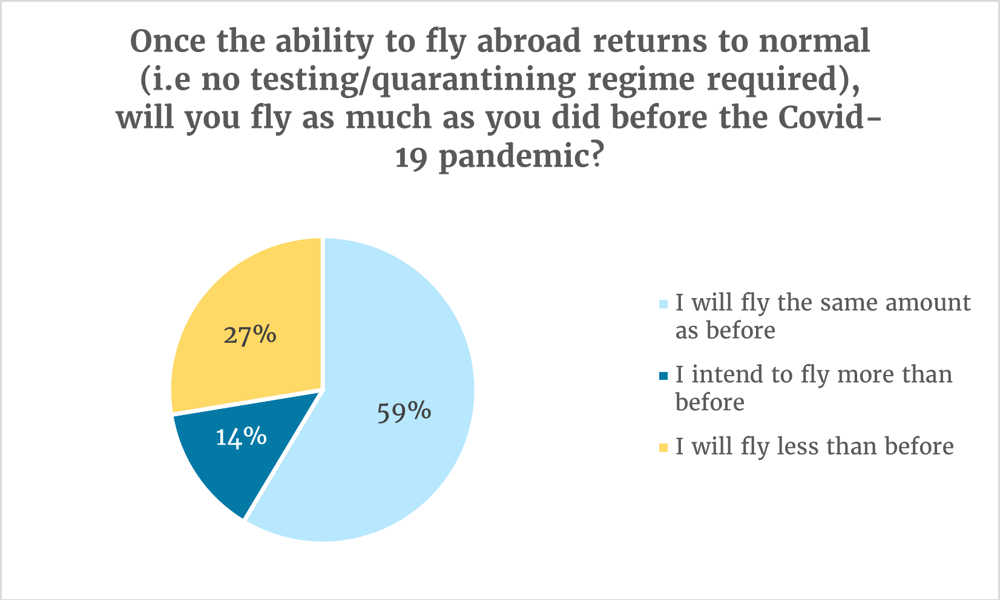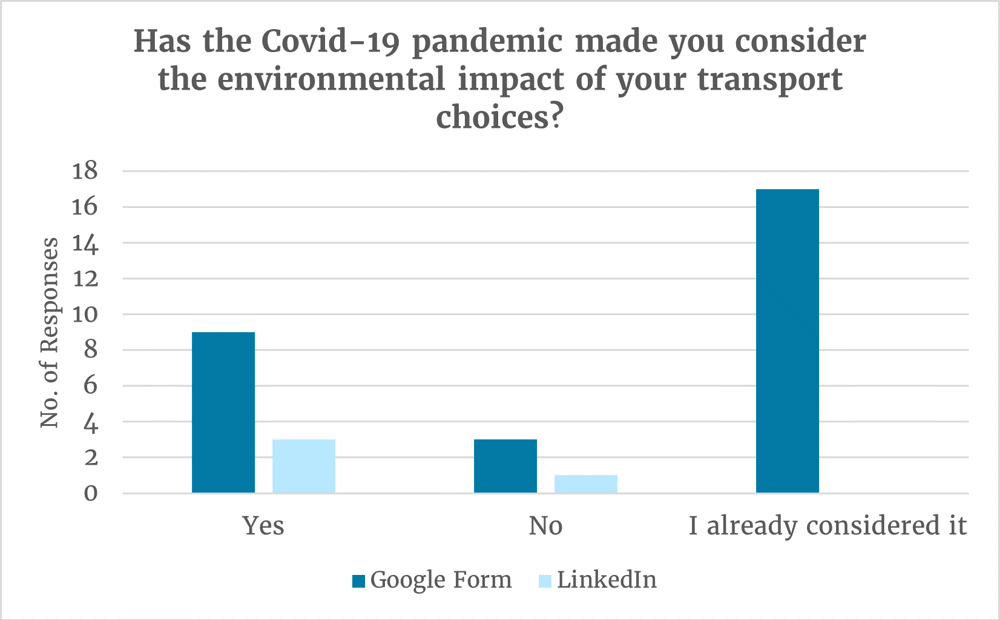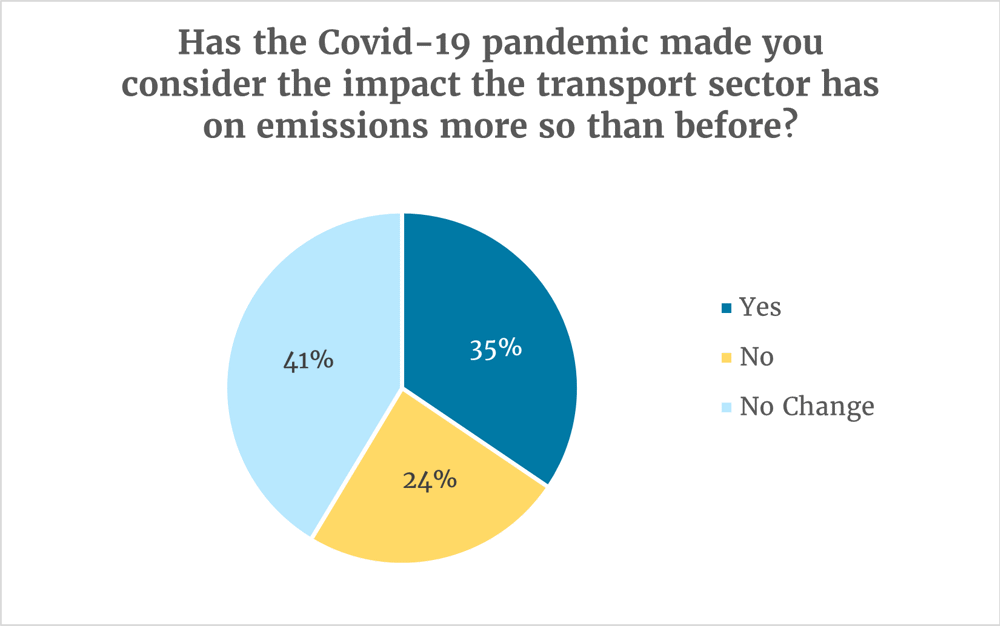After nearly 16 months of lifestyle restrictions as a result of the Covid-19 pandemic, on the 19th of July 2021, the large majority of remaining restrictions in England were removed. Only a few remain, currently centring around travel abroad.
The lifting of restrictions has seen a return to nightclubs, large scale events and offices, naturally resulting in a higher number of trips on transport networks each day. However, there is still an element of remaining ‘travel fear’, particularly in regard to the use of public transport.
It is therefore interesting from a transport planning perspective to understand whether various forms of mobility will return to levels seen pre-pandemic, or whether some ‘Covid Trends’ are here to stay.
Mayer Brown has undertaken a survey entitled ‘The Impact of Covid-19 on Travel Choices’, with questions covering attitudes towards different travel methods in a post-Covid-19 environment. It is important to caveat that at the time of the survey (August 2021), the pandemic was still ongoing, however the bulk of restrictions on lifestyle had been lifted. The majority of responses were collected via a questionnaire; however, a few questions were also asked on LinkedIn in order to widen the study group.
Use of public transport
Throughout the pandemic, social distancing has been encouraged, leading to significant reductions in the maximum capacity of bus and train services. Now that these limits have been withdrawn, and with exciting developments coming forward in the bus and transit market, it is important for market researchers and service planners to gauge an idea on how much of a demand there will be for public transport facilities.
The following questions were therefore designed to get an understanding of public opinion surrounding public transport use going forward.
Figure 1: Likelihood of Public Transport Use Return
Figure 2: Personal Attitude towards Public Transport Use Post-pandemic
Figure 1 indicates that 100% of respondents who responded via the questionnaire believe that public transport use will return to pre-pandemic levels, albeit in the distant future. Comparably, 46% of respondents from LinkedIn felt that public transport use will not return to pre-pandemic levels at all.
Figure 2 reinforces the idea that a return to pre-pandemic level of public transport use is unlikely, with 45% of responses indicating they are less likely to use public transport now than before.
These results are somewhat in line with those reported by Transport Focus[1] (published March 2021, data collected 19-21 February 2021), who found that a third of respondents felt they would never feel completely comfortable on public transport again. This percentage was much higher for those who identified as clinically vulnerable, of which nearly 50% wouldn’t feel comfortable again.
Transport Focus also asked if once restrictions were lifted, respondents expected to use public transport as much as before the pandemic, of which 46% thought they would.
The research from Mayer Brown and Transport Focus therefore suggests that public transport use is unlikely to return to pre-pandemic levels, at least not till the distant future.
Active Travel Choices
A number of our blogs have previously touched on the significant increase in uptake of active travel modes during the pandemic. Now that employees in the UK have gradually been returning to their offices, there is an opportunity to understand if these trends are set to continue.
Figure 3 below provides an indication of the attitude towards active travel:
Figure 3: Change in Active Travel Uptake Post-Covid-19
Figure 3 shows that 38% of respondents said they were more likely to choose active travel options when making a journey compared to before the pandemic. This is in line with the research conducted by Transport Focus, who found that once restrictions ended, 37% of respondents who walked previously intended to walk more in the future, and 27% of those who cycled would cycle more in the future.
It therefore appears that the increase in walking in cycling as a result of the coronavirus pandemic, reported by the National Travel Attitudes (NTA) survey in January 2021[2] (data collected between May and September 2020), is likely here to stay as a more permanent change.
The NTA survey found that 38% of pre-pandemic walkers now walk more than before the pandemic, and 34% of pre-pandemic cyclists cycle more than before the pandemic, which aligns well with the most recent research conducted by Mayer Brown in August 2021.
From a planning perspective, this reinforces the importance of creating walkable neighbourhoods and ensuring that cyclists and pedestrians are put at the heart of forthcoming developments. It is clear that walking space in the public domain has never been more of a priority.
Vehicle and Air Travel
The significant changes in lifestyle provoked by the Covid-19 crisis saw a steep decline in air travel and use of the private car for a period of time. Now that the majority of restrictions on travel have lifted, albeit the testing regime for international travel, an increase in traffic on the road network and uptake on flights has been noticeable.
The following questions therefore explore the lasting effect of the pandemic on these methods of transport.
Figure 4: Use of the Private Car Post Covid-19
Figure 4 indicates that since the pandemic, 11% of respondents reported to be using their car more, 32% were using it less and 57% had no change in use.
Figure 5: Intend to use Air Travel Post-Pandemic
Perhaps the area of the transport sector faced with the most challenges as a result of the Covid-19 pandemic, it is certainly interesting to see that 59% of respondents intend to fly the same amount as before, and 14% intend to fly more than before.
However, while positive intentions are there, the recovery of the airline industry may not be for a long time. Research such as that from Mckinsey[3] expects airline traffic not to return to 2019 levels before 2024, citing that business travel will take longer to recover than leisure trips. This is likely due to the continued uptake of flexible working arrangements.
Moreover, with just over a quarter of respondents stating they will fly less than before, it is probable that the road to recovery for the aviation sector will be longer than others.
Consideration of Transport Choices
A number of factors have played into the change of transport habits over the last 18 months. Restrictions on travel distances encouraged an uptake in walking and cycling, anxiety surrounding the safety of public transport led to a reduction in usage, working from home cut out the need for a commute.
However, the pandemic has also provided the opportunity for many to make a greener choice when it comes to selecting their mode of transport, and therefore a few questions were included in the survey to gauge if this was happening.
Figure 6 indicates that while the majority of respondents to the questionnaire already considered the environmental impact of their transport choices, a certain proportion now consider it as a direct result of the pandemic.
Figure 7 also indicates that the pandemic has led to a number of people considering the impact of the transport sector as a whole more than before. This research is important as it contributes to the uptake or reduction in demand for certain modes of transport. Transport planners and operators need to take into account public attitude and ensure that appropriate services and facilities are provided going forward.
Post Covid Travel
Based on the findings of the survey, it would be reasonable to assume that a return to public transport and air travel to the levels seen pre-pandemic may not happen immediately. Particularly notable is the finding that 45% of respondents are less likely to use public transport than before. However, it is likely that the increased uptake in active methods of travel is a trend here to stay.
Therefore, those involved in transport planning services, town and development planning and transport operators should take into account the shift in demand and ensure that pedestrian and cyclists are put at the heart of decisions going forward.
[3]The Future of the Airline Industry After COVID-19 | McKinsey
